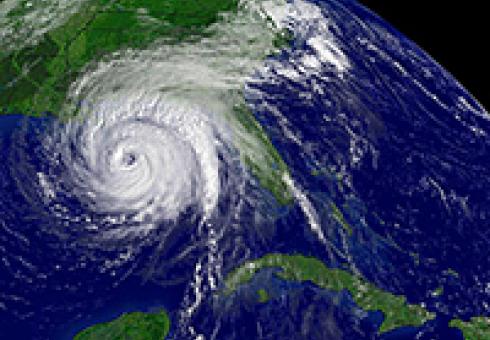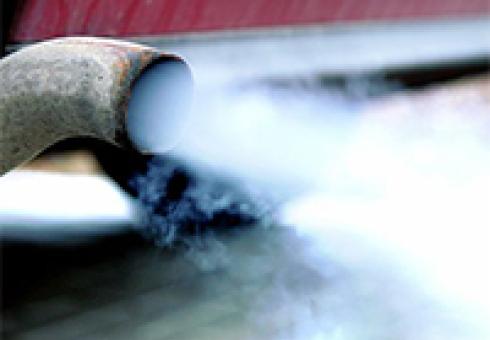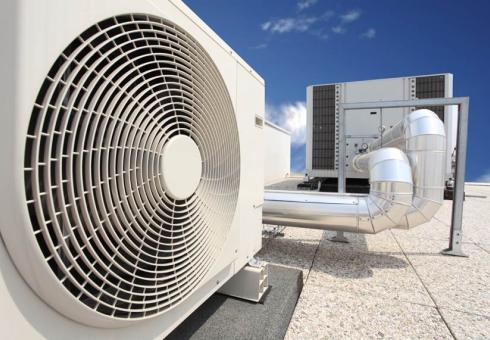CS3 In the News
New research in China quantifies the relationship between reduced life expectancy and elevated air pollution from coal fired boilers. MIT professor Michael Greenstone tells host Steve Curwood that residents in the north of China live 5 years less on average than those in the south as a result of higher exposure to air pollution from coal combustion.
Air pollution has taken a toll on the health of Chinese residents. A person living in the north of the River Huai can expect to lives 5 years less than a person south of the river, an unintended legacy of the government’s policy to give free coal for winter heating in the north of the country. (US Embassy)
New research in China quantifies the relationship between reduced life expectancy and elevated air pollution from coal fired boilers. MIT professor Michael Greenstone tells host Steve Curwood that residents in the north of China live 5 years less on average than those in the south as a result of higher exposure to air pollution from coal combustion.
Transcript:
CURWOOD: Highly polluted air is bad for your health, and that's particularly true when it's air full of small particles from coal-fired power plants, as studies going back for years have shown. But just how bad? Now for the first time, there's a study that actually quantifies how many years of life expectancy are lost to a given amount of particulate exposure. Michael Greenstone is a Professor of Environmental Economics at MIT. He recently published a paper that compared two populations in China that experienced very different levels of polluted air.
GREENSTONE: The basis of the study comes from a Chinese policy that was implemented during the Planning Period.
CURWOOD: This was back in the 1980s we’re talking about.
GREENSTONE: It dates really from the 1950s to the 1980 period, although the legacy of the policy remains to date. But they didn’t have enough money to provide winter heating for everybody, so they somewhat arbitrarily decided that people who live north of the Huai River, which bisects the country into north and south, would have free winter heating, and that was provided through free coal and building the infrastructure to combust the coal to create heat. And the basis of the study is to compare people who live just north of the river with people who live just to the south of the river. And I should add, in the south, it was forbidden to build heating units.
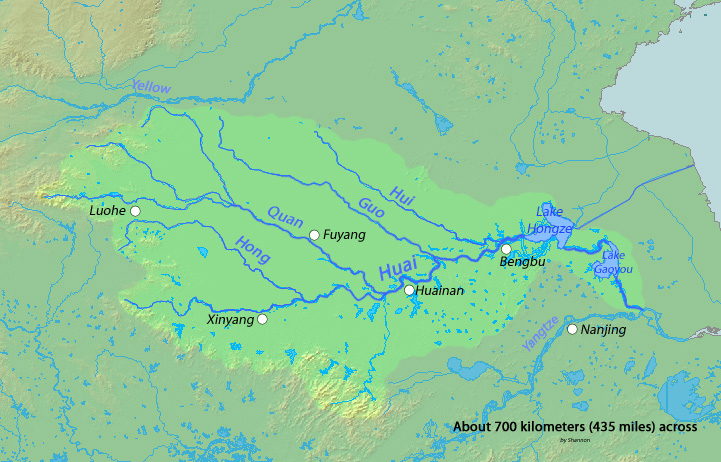
So what the study did then is it got data from 1981 to 2000 on pollution, and what we find is pretty dramatic. Living north of the river led to almost 200 micrograms per cubic meter increase in total systemic particulates. Now, of course, most people aren’t familiar with those units, so to put it in context, it was about 350 micrograms per cubic meter in the south, and 550 micrograms per cubic meter in the north, and by comparison, the US average right now is probably 40 or 50. So both the levels are enormous, and the difference between the north and south is also enormous.
CURWOOD: So what did you find when you compared life expectancy for residents in the north versus the south?
GREENSTONE: It’s remarkable. So, as I mentioned, just at the river’s edge there’s a jump up in particulates concentrations, and that’s matched by a jump down in life expectancy. Specifically, what we found is people who live north of the Huai River, and were the intended beneficiaries of these policies, have life expectancy about five-and-a-half years less than people who live to the south.
CURWOOD: How many people live in that area to the north?
GREENSTONE: In north China there’s about 500 million people, and so, from that, we deduced that the policy is causing a loss of approximately 2.5 billion life years.
CURWOOD: What kind of illnesses? What kind of deaths were these people going through?
GREENSTONE: All of the effects appear to be coming from elevated mortality rates due to cardiorespiratory causes of disease that are plausibly related to air pollution. So, lung cancer, heart attacks, other respiratory diseases. In contrast, we find no affect on mortality rates associated with causes of death that are non-cardiorespiratory.
CURWOOD: Where you able to break out just how much particulate would lead to just how much lower life expectancy?
GREENSTONE: Yes. So, in particular what we find is that an extra hundred micrograms per cubic meter of total suspended particulates is associated with a loss of life expectancy of about three years. And why that’s important is that that can be applied to other settings, both in other countries, and in other parts of China as well.
CURWOOD: Now the wind can carry air pollution from China across the Pacific Ocean to North America. Should people, say, in California be concerned about air pollution from China?
GREENSTONE: There’s always a concern about that, and it would definitely be the smaller particles that would be able to travel that far. I think probably the larger concern for Americans and really everyone who lives on the planet are the increasing rates of carbon dioxide emissions coming from China, which is a completely different pollutant, but is also associated with the combustion of coal and is causing climate change.
CURWOOD: So you don’t worry so much about particulates, you worry about CO2.
GREENSTONE: Yes. I mean, it’s worth emphasizing that China consumes more than half of the world’s coal.
CURWOOD: So what policies does China have now regarding this use of free heat in the north? And what are they doing to address the obvious public health problem?
GREENSTONE: Yes, so the legacy of the policy continues. It’s not quite in the same form. I don’t think the government is running around installing boilers anymore, but they continue to subsidize coal in the north. As an example, I’ve lectured at a university in Chengdu which is a city that’s in the south but it’s in the northern part of the south so they have cold winters. And it was just normal occurrence that when I was lecturing there was no heat in the building and all the students were wearing winter coats. So the legacy of this policy continues today. With respect to policy looking forward, I think what this study has helped to highlight is that consequences of air pollution in terms of human health are greater than what had been previously realized. And perhaps it will tilt the balance as they try to devise the optimal tradeoff between air pollution and increasing incomes.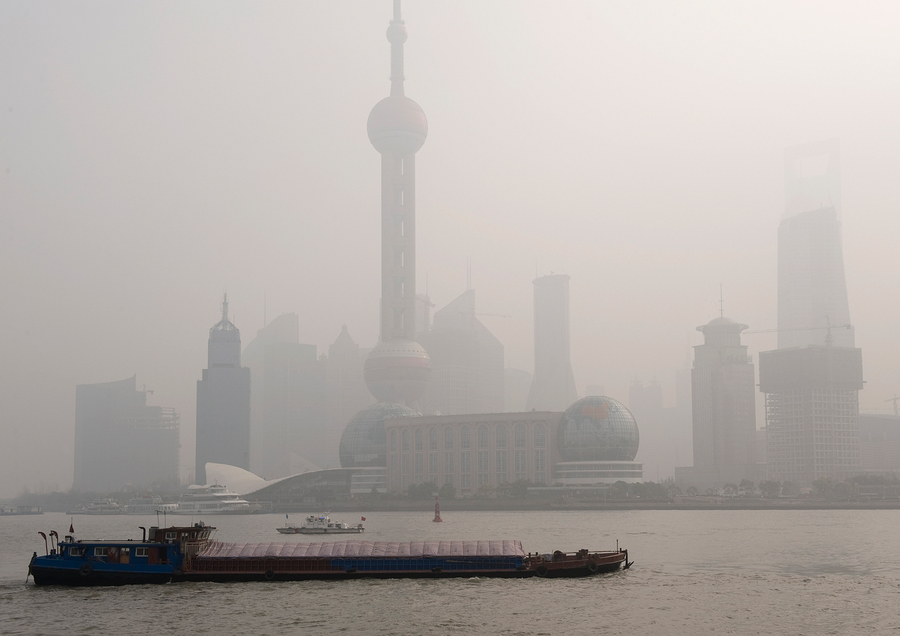
CURWOOD: What has been the response to your study in China, privately as well as publicly?
GREENSTONE: Two of my co-authors are Chinese. One of them reported that on his microblog he had 300,000 hits in the first eight hours, and that was in response to a post describing the results. I think in the coming days and months, it will be very interesting to see what the impacts are, and the degree to which it affects Chinese policy. Candidly, China has an opportunity here to greatly improve the health of its citizens.
CURWOOD: Michael Greenstone is Professor of Environmental Economics at the Massachusetts Institute of Technology. Thanks so much, Professor Greenstone.
GREENSTONE: Thank you for having me.
Existing research suggests that hurricanes could become stronger but less frequent thanks to climate change. But a new study says both could happen.
(Also covered by USA Today)
By: Bryan Walsh
Maybe Mayor Michael Bloomberg would have gone through the troubling of putting together a 430-page report outlining a $19.5 billion plan to save New York from the threat of climate change had Hurricane Sandy not hit last year and inflicted some $20 billion in New York City alone. But somehow I doubt it. There’s a reason that a satellite image of Hurricane Katrina highlighted the poster for An Inconvenient Truth, or that belief in man-made global warming tends to spike after extreme weather. Heat waves are uncomfortable and drought is frightening, but it’s superstorms—combined with the more gradual effects of sea-level rise—that can make climate change seem apocalyptic. Just read Jeff Goodell’s recent piece in Rolling Stone about what a major hurricane might be able to do to Miami after a few decades of warming.
But there was one hopeful side effect to climate change, at least when it came to tropical storms. The prevailing scientific opinion—seen in this 2012 report from the Intergovernmental Panel on Climate Change—is that while tropical storms are likely to become more powerful and rainier as the climate warms, they would also become less common. Bigger bullets, slower gun.
A new study in the Proceedings of the National Academy of Sciences, however, suggest that we may not be so lucky. Kerry Emanuel, an atmospheric scientist at the Massachusetts institute of Technology (MIT) and one of the foremost experts on hurricanes and climate change, argues that tropical cyclones are likely to become both stronger and more frequent as the climate continues to warm—especially in the western North Pacific, home to some of the most heavily populated cities on the planet. But the North Atlantic—meaning the U.S. East Coast and Gulf Coast—won’t be spared either. Bigger bullets, faster gun
Emanuel is going up against the conventional wisdom and much of the published literature with this paper. But the reality is that we don’t have a very good grasp of how tropical cyclone formation or strength might change in the future. As Adam Freedman points out at Climate Central, hurricanes may be huge, but they’re still too small to be easily tracked by computer climate models, which do better on a larger scale. Emanuel embedded higher-resolution regional and local models into an overarching global framework. Emanuel’s “downscaled” model simulates the development of tropical cyclones at a resolution that will increase as the storm gets stronger. For each of the six IPCC global climate models, Emanuel simulated 600 storms every year between 1950 and 2005, then ran the model forward to 2100, using an IPCC forecast that has global carbon dioxide emissions tripling by the end of the century.
Emanuel’s simulations found that the frequency of tropical cyclones will increase by 10 to 40% by 2100. And the intensity of those storms will increase by 45% by the end of the century, with storms that actually make landfall—the ones that tend to smash—will increase by 55%. As Emanuel told LiveScience:
We see an increase, in particular, toward the middle of the century. The results surprised us, but we haven’t gotten so far as to understand why this is happening.
OK, big caveats here. Emanuel is a very well-respected climatologist, but it always takes more than a single study to overturn existing scientific opinion—especially if that opinion is itself a little wobbly. Georgia Tech climatologist Judith Curry, who falls on the more skeptical side of the scientific debate on climate change, told this to Doyle Rice of USA Today:
The conclusions from this study rely on a large number of assumptions, many of which only have limited support from theory and observations and hence are associated with substantial uncertainties. Personally, I take studies that project future tropical cyclone activity from climate models with a grain of salt.
We’ll see in the decades to come whether Emanuel is right. But in a way, it may not matter all that much. As Sandy showed, hurricanes already pose a tremendous threat to our coastal cities. And that threat will continue to grow no matter what climate change does to tropical storm frequency or intensity because we’re putting more and more people and property along the water’s edge. Remember Miami? In 1926 the city was devastated by a Category 4 hurricane. (Sandy barely ranked as a Category 1 by the time it made landfall.) The difference is that there wasn’t much of a Miami back in 1926—the city’s population had just passed 100,000. Today more than 2.5 million people call Miami-Dade county home, and a hurricane of the same sort that hit in 1926 that hit now would cause $180 billion in damages. Whatever climate change does to hurricanes, we need to be ready.
With global warming, a study finds, tropical cyclones may become more frequent and intense.
This is the first post of a multi-part series on Transforming China’s Grid, where Michael Davidson will be critically examining China’s efforts to reinvent and decarbonize its power sector and related energy goals. He begins with China’s efforts to create provincial and city-level carbon trading pilots as well as major obstacles to establishing a national system that can link with other ETS markets.
By Michael Davidson
China’s first mandatory carbon emissions trading system (ETS) pilot debuted last month before a packed auditorium in the southern city of Shenzhen. China’s first official carbon trade was greeted with fanfare and a well-choreographed script of climate officials. Shenzhen is the first of seven cities and provinces expected to unveil cap-and-trade programs in China this year, which drew skeptical reactions from foreign onlookers based on the first day’s low volume – 21,120 tons at 28-30 yuan / ton ($4.55-$5.05).
The ETS pilots are a small market-based component of a broader climate policy that has historically relied on administrative measures carried in five-year plans. The overriding priorities for provincial officials are energy and carbon intensity reduction targets, most recently allocated in 2011. Nationally, these amount to 16% and 17% reductions in energy use and carbon emissions per unit GDP, respectively, by 2015; a 40-45% carbon intensity reduction below 2005 levels by 2020. However, ensuring an early emissions peak (i.e., before 2030) will require more flexible approaches, in particular, market mechanisms, for which the ETS pilots are a useful bellwether. While the merits of the pilots should not be judged by the first trading day, significant obstacles stand in the way of creating a national ETS by 2016, as currently envisioned by the Chinese leadership. Even before the remaining six trading pilots ring the opening bell, we have a good sense of what these obstacles will be.
Read the rest on The Energy Collective...
A new study links heavy air pollution from coal burning to shorter lives in northern China.
(Also covered by WSJ, WaPo, NYT, Reuters, Bloomberg, LA Times, Nat Geo, Nature, Discover, CNN, BBC, Guardian, Sky News, International Business Times, Financial Times, The Telegraph, Daily Mail, China.org)
By Lousie Watt
BEIJING (AP) — A new study links heavy air pollution from coal burning to shorter lives in northern China. Researchers estimate that the half-billion people alive there in the 1990s will live an average of 5½ years less than their southern counterparts because they breathed dirtier air.
China itself made the comparison possible: for decades, a now-discontinued government policy provided free coal for heating, but only in the colder north. Researchers found significant differences in both particle pollution of the air and life expectancy in the two regions, and said the results could be used to extrapolate the effects of such pollution on lifespans elsewhere in the world.
The study by researchers from China, Israel and the United States was published Tuesday in the Proceedings of the National Academy of Sciences.
While previous studies have found that pollution affects human health, "the deeper and ultimately more important question is the impact on life expectancy," said one of the authors, Michael Greenstone, a professor of environmental economics at Massachusetts Institute of Technology.
"This study provides a unique setting to answer the life expectancy question because the (heating) policy dramatically alters pollution concentrations for people who appear to be of otherwise identical health," Greenstone said in an email. "Further, due to the low rates of migration in China in this period, we can know people's exposure over long time periods," he said.
The policy gave free coal for fuel boilers to heat homes and offices to cities north of the Huai River, which divides China into north and south. It was in effect for much of the 1950-1980 period of central planning, and, though discontinued after 1980, it has left a legacy in the north of heavy coal burning, which releases particulate pollutants into the air that can harm human health. Researchers found no other government policies that treated China's north differently from the south.
The researchers collected data for 90 cities, from 1981 to 2000, on the annual daily average concentration of total suspended particulates. In China, those are considered to be particles that are 100 micrometers or less in diameter, emitted from sources including power stations, construction sites and vehicles.
The researchers estimated the impact on life expectancies using mortality data from 1991-2000. They found that in the north, the concentration of particulates was 184 micrograms per cubic meter — or 55 percent — higher than in the south, and life expectancies were 5.5 years lower on average across all age ranges.
The researchers said the difference in life expectancies was almost entirely due to an increased incidence of deaths classified as cardiorespiratory — those from causes that have previously been linked to air quality, including heart disease, stroke, lung cancer and respiratory illnesses.
Total suspended particulates include fine particulate matter called PM2.5 — particles with diameters of no more than 2.5 micrometers. PM2.5 is of especially great health concern because it can penetrate deep into the lungs, but the researchers lacked the data to analyze those tiny particles separately.
The authors said their research can be used to estimate the effect of total suspended particulates on other countries and time periods. Their analysis suggests that every additional 100 micrograms of particulate matter per cubic meter in the atmosphere lowers life expectancy at birth by about three years.
The study also noted that there was a large difference in particulate matter between the north and south, but not in other forms of air pollution such as sulfur dioxide and nitrous oxide.
Francesca Dominici, a professor of biostatistics at Harvard School of Public Health who has researched the health effects of fine particulate matter in the U.S., said the study was "fascinating."
China's different treatment of north and south allowed researchers to get pollution data that would be impossible in a scientific setting.
Dominici said the quasi-experimental approach was a good approximation of a randomized experiment, "especially in this situation where a randomized experiment is not possible."
She said she wasn't surprised by the findings, given China's high levels of pollution.
"In the U.S. I think it's pretty much been accepted that even small changes in PM2.5, much, much, much smaller than what they are observing in China, are affecting life expectancy," said Dominici, who was not involved in the study.
Listen to the Summary Story
Listen to the Full Story
Climate change seems like this complicated problem with a million pieces. But Henry Jacoby, an economist at MIT's business school, says there's really just one thing you need to do to solve the problem: Tax carbon emissions.
"If you let the economists write the legislation," Jacoby says, "it could be quite simple." He says he could fit the whole bill on one page.
Basically, Jacoby would tax fossil fuels in proportion to the amount of carbon they release. That would make coal, oil and natural gas more expensive. That's it; that's the whole plan.
Jacoby's colleague John Reilly told me the price of gasoline might rise by 25 cents a gallon in the first year. Over time, that would increase. By 2050, Reilly figures the carbon tax would add about $1 to the price of every gallon. Across the economy, prices of energy-intensive goods and services would rise. This would encourage people and businesses to be more efficient.
This is why economists love a carbon tax: One change to the tax code and the entire economy shifts to reduce carbon emissions. No complicated regulations. No rules for what kind of gas mileage cars have to get or what specific fraction of electricity has to come from wind or solar or renewables. That's by and large the way we do it now.
Reilly says the current web of rules is a more complicated and more expensive way of getting the same outcome as a carbon tax. The current system "pretty much is one of the worst ways we could do it," he says.
As with any fix for climate change, a carbon tax would hit some people harder than others. People with long commutes would pay more. People who work in coal mines could lose their jobs.
But here is where Reilly brings up what is perhaps the most surprising thing about a carbon tax: If you do it right, he says, carbon tax can be nearly painless for the economy as a whole.
Besides reducing carbon emissions, a carbon tax brings in a bunch of money – it's a tax after all. So, Reilly says, you can reduce, say, income tax to balance out the new taxes people are paying for carbon emissions. People pay more for gas, but they get to keep more of their income.
I called around and talked to a bunch of economists about this, and they said the basic idea was sound: If you give the carbon-tax money back by cutting income taxes, you can probably offset a lot of the pain.
President Obama has indicated he would support a market-based solution to climate change. But a carbon tax would of course require an act of Congress. And right now, that seems unlikely.
By: Joel Kirkland and Peter Behr
June 26, 2013
President Obama's plan to use a mixture of mandates and flexible regulation to cut greenhouse gas emissions is being viewed by energy industry experts through an age-old axiom: The devil is in the details.
The plan appears to be a shot in the arm for natural gas, as Obama's proposed regulation of carbon dioxide emissions from existing coal-fired power plants would provide a boost to cleaner-burning gas generators.
The White House's second-term climate agenda faces daunting head winds. Opposition from Republicans and resistance from coal-state Democrats, and the nuts and bolts of crafting a policy that would mark a significant shift for the nation's electric power industry, are immediate hurdles. Court challenges could create a protracted process for regulating carbon, as it has for U.S. EPA regulations of toxic air pollutants pushed through by the Obama administration.
But the daily stir of coal, natural gas and electricity markets in the United States also matters. With details of the new carbon policy still to come, unpredictable market prices will continue to be an underlying driver of decisions by electricity producers about where to invest and what energy sources to dispatch. Abundant coal will battle it out with growing shale gas production, several experts interviewed by EnergyWire predicted.
"There is no disagreement that the environmental regulations, many of which were proposed during the Bush administration, are going to bind and cause several -- tens of gigawatts -- of coal plants to be uneconomic," said Jay Apt, director of the Electricity Industry Center at Carnegie Mellon University. "If gas prices stay reasonable, then people will be buying gas plants.
Obama rolled out his climate plan in the blistering summer heat. Yesterday's speech on a Georgetown University quad rested on the premise that rising concentrations of heat-trapping gases in the atmosphere are the result of industrial emissions and that unregulated U.S. power sector emissions are contributing too much to rising temperatures.
The White House directive for EPA to begin drawing up a proposal to regulate existing coal-fired power plants had already been set in motion. In 2007, the Supreme Court ruled that EPA could not sidestep its authority to regulate emissions tied to climate change. The agency later issued an "endangerment finding" that created a legal foundation for regulating carbon.
"We limit the amount of toxic chemicals like mercury and sulfur and arsenic in our air and water, but power plants can still dump unlimited amounts of carbon pollution into the air for free," Obama said in the speech. "That's not right, that's not safe, and it needs to stop."
Carbon economics
How you get there might be left up to the most unpredictable factor of them all: the economy.
"If you want to stabilize the concentration of carbon dioxide in the atmosphere, you need a substantial reduction of emissions," Apt said.
"Meeting greenhouse gas targets in a flat-growth economy, where the industrial use of electric power is the same now as it was in the early 1990s, is very different than a scenario in which you blithely say growth is going to be 3 percent a year," he said.
A range of factors affect the immediate future of electric power generation, said Metin Celebi, a principal with the Brattle Group. "The most important one is the gas price relative to the coal price," Celebi said.
The future direction of that price is anyone's guess, given how many questions remain about the pace of shale gas production.
Of the nation's approximately 300 GW of coal-burning power generation capacity, nearly 40 GW was targeted for retirement by 2016, according to a Brattle analysis.
More "lenient" regulatory controls, along the lines expected from the Obama administration, could cause that total to rise to nearly 60 GW, the Brattle report says. A very strict policy could raise that to 77 GW of coal plant capacity retirements.
Lower gas prices plus strict regulations could cause almost half of the U.S. coal fleet to retire, a scenario that Celebi and his colleagues concluded in an October 2012 report would likely be untenable for electricity producers.
This shift is occurring for both short-term price and longer-range policy reasons that are not easy to separate. Most energy companies expect that at some point, an explicit or implicit price will be placed on power plant carbon emissions, and that particularly burdens coal plants, whose carbon footprint is twice that of efficient gas generators, said Katherine Spector, executive director of commodities strategy for CIBC World Markets Corp.
That expectation affects companies' decision on retiring or retaining older, inefficient coal plants. "It's actually a combination of the two" -- price and policy -- "and the policy environment could significantly accelerate the trend," Spector said.
The drop in natural gas prices over the past two years has tilted production in gas's favor, particularly in competitive power markets where the two kinds of power plants seek low-bid opportunities to run hour by hour.
Until shale gas production flattened gas prices, coal held a solid lead. In April 2011, coal-fired plants accounted for 41 percent of electric power output, compared to 23 percent for natural gas. A year later, the two fuels' shares were almost identical. Then gas prices moved up again from less than $2 per thousand cubic feet to $4 recently, and coal made a comeback. Its share of electricity production was 38 percent this April compared to 26 percent for gas.
But an expectation of relatively cheap gas also affects decisions on the future of coal plants. "It is a different world in gas prices than we had three or four years ago," Celebi said. "Gas price projections have come down substantially, and that's something you can put more weight on."
The Energy Information Administration, the statistical arm of the Energy Department, noted in its 2013 annual energy outlook that "the interaction of fuel prices and environmental rules is a key factor in coal plant retirements."
For all the price and production scenarios EIA considered, less than 15 GW of new coal-fired capacity would be added between 2012 and 2040. "For new builds, natural gas and renewables generally are more competitive than coal, and concerns surrounding potential future GHG [greenhouse gas] legislation also dampen interest in new coal-fired capacity," EIA said.
Shutting one-third of coal
A 2012 paper by a team led by Massachusetts Institute of Technology researcher Henry Jacoby said the increased gas supply boosts the power industry's flexibility to meet baseload electricity demand if expectations about nuclear power don't pan out or coal retirements speed up.
Under an aggressive policy to slash carbon that requires a 50 percent emissions reduction below 2005 levels by 2050, there would have to be "substantial changes in energy technology."
If the development of shale gas became too expensive, gas use would "grow slightly for a few decades." Toward the end of that period, however, "it would be priced out of this use because of the combination of rising producer prices and the emissions penalty."
Renewable energy would grow to 29 percent of power demand, and coal would keep a substantial position in the power pie.
Fact sheets issued by the administration yesterday left crucial questions about the policy plans unanswered, noted ClearView Energy Partners, "especially the threshold levels of emissions that will govern new and existing [generation] units."
On a back-of-the-envelope assessment, ClearView said that if the administration adopts a formula proposed by the Natural Resources Defense Council calling for a limit of 1,500 pounds of CO2 equivalent per megawatt-hour of electricity production, it could add another 70 GW of coal plant retirements by 2020. That's on top of the 40 GW of expected retirements tied to current EPA rules on mercury emissions and air toxins, the ClearView analysis said.
"In the aggregate, this adds up to a shutdown of roughly one-third of U.S. coal-fired generating capacity within the space of a decade," ClearView said. "Program design matters, too. The inclusion of offsetting emissions reduction mechanisms could keep more coal online."
Republicans in Congress have accused the Obama administration of threatening grid reliability through its pressures on coal-fired generation.
Celebi said that remains a big question. "It depends on where and when those plants retire," he said. "If it's a long period of time, the markets will have a chance to respond by cutting consumption or adding other resources.
"If it's too much, too quick, that will not be feasible," he said.
State foot-dragging
Politics soured the policy debate starting in 2009, electricity demand declined as the economy slumped, and natural gas prices fell to record lows in 2012.
Meanwhile, the technology-driven onshore drilling boom has turned up a "bridge fuel" to cleaner forms of electricity. And the White House has been openly supporting gas's role in combating climate change and spurring economic growth, despite concerns about methane emissions -- a potent greenhouse gas -- tied to upstream gas production.
"Sometimes there are disputes about natural gas," Obama said yesterday. "But let me say this: We should strengthen our position as the top natural gas producer because, in the medium term at least, it not only can provide safe, cheap power, but it can also help reduce our carbon emissions."
For electric utilities, the latest White House climate plan comes nearly four years after a bruising period of political wrangling over carbon cap-and-trade legislation. In 2009, the Edison Electric Institute was mired in the details of a bill that would distribute emissions credits for power generators to buy and sell under a carbon pollution cap. EEI's Tom Kuhn, president of the trade group of investor-owned utilities, had put together a fragile coalition of companies that could support the approach to ratcheting down emissions.
The premise behind the coalition-building had been that it's better to have a "market-based" program shaped by Congress than to leave it to top-down EPA regulations under the existing Clean Air Act.
The House passed the cap-and-trade bill by a slim margin in the summer of 2009, a signature achievement for House Democrats, but one that rested on compromises too politically hot for the Senate. The divisive debate revved up an opposition campaign targeting the science and politics of climate change. Republican leaders used the defeated legislation as a cudgel in the 2010 elections.
Since then, EPA has continued to tighten rules around conventional pollutants. New plants will have to comply with Mercury and Air Toxics Standards (MATS) rules. Other regulations addressing water intake and cooling water discharge are also shaping utility industry plans. Conventional coal gradually is being forced out of power portfolios.
Also on the table is an EPA draft rule that would cap carbon emissions at 1,000 pounds per megawatt-hour of generation for newly built power plants. The standard, which encourages fuel-switching to gas, would put the kibosh on new coal-fired power plants.
In a prepared statement after the president's speech yesterday, EEI's Kuhn urged EPA to put in place measures that "contain achievable compliance limits and deadlines" and "are consistent with the industry's ongoing investments to transition to a cleaner generating fleet and enhanced electric grid."
"It is also critical that fuel diversity and support for clean energy technologies be maintained, not hindered," Kuhn added.
The slowdown in electricity demand in the United States has helped enable efficiency technology and power plant retrofits to control pollution. But analysts and executives from powerful utilities like Georgia-based Southern Co. and Ohio-based American Electric Power Co. Inc. have said carbon limits pose the biggest risk to their coal fleet.
State utility commissions responsible for regulating power plants could slow the shift to low-carbon standards, analysts said.
"There will be litigation and foot-dragging on the part of some states in developing implementation plans," said Adele Morris, an energy economist at the Brookings Institution. "I think EPA is in the early stages of what they would even propose."
By: Elizabeth Rowe
June 25, 2013
We all know that air conditioning eats up an enormous amount of energy. We also know that installing ceiling fans would allow us to use the air conditioner a lot less. And we all know the savings over time would pay for the ceiling fan. So why aren’t there more people buying ceiling fans?
That question, and many more like it, are at the center of a research project launched by the Haas School of Business at the University of California at Berkeley and MIT’s Center for Energy & Environmental Policy Research (CEEPR). The initiative, known as the E2e Project, will work to understand cost-effective ways to reduce energy use and the obstacles that sometimes get in the way.
Drawing on the skills of both engineers and economists from MIT and Berkeley, the project derives its name from its mission: finding a smart way to go from using a larger amount of energy, or “E,” to a smaller amount of energy, or “e.”
Much of the impetus for this project comes from the McKinsey Curve, a cost curve that asserts that there are “negative cost” energy efficiency investments that essentially pay for themselves. “There’s a fair bit of evidence out there that suggests there’s a lot of low-hanging fruit in terms of energy savings, but much of that evidence is based on engineering models,” says E2e co-director Christopher Knittel, a professor at MIT’s Sloan School of Management and CEEPR co-director. “Much of the engineering research ignores behavioral changes that might come in response to those investments, and those behavioral changes can manifest themselves in many ways.”
For example, Knittel says, households might turn their thermostat down in the summer or up in the winter if heating and cooling homes become more energy-efficient. Such behaviors, which reduce the benefits of energy efficiency, aren’t accounted for in engineering models, he says.
One study undertaken by E2e will determine how much energy the federal Weatherization Assistance Program saves. The project examines low-income households in Michigan that received free efficiency upgrades, such as insulation and weatherproofing, and audits their energy use over time to find out why actual efficiency gains are less than expected. Final results are expected later this year.
According to Knittel, E2e has three main objectives. One is to determine whether these “negative-cost” investments truly exist. The second is to understand which of these investments has the greatest return on investment. And third, E2e will try to understand why consumers and companies aren’t making these investments if they truly have a negative cost.
E2e’s co-director, Professor Catherine Wolfram, an associate professor at Haas and co-director of the Energy Institute, says E2e has a broader goal, too: “At the heart, I think we’re interested in finding the lowest-cost way to mitigate climate change.” She adds, “In the short term we hope to deliver to policymakers some really good information about where human behavior might influence energy efficiency technology and policy.”
John Reilly, co-director of the Joint Program on Global Change, served on the committee responsible for a new National Research Council (NRC) report on the “Effects of U.S. Tax Policy on Greenhouse Gas Emissions.”
The report found that while tax policies can make a substantial contribution to meeting the nation's climate change objectives, the current approaches do not. In fact, current federal tax provisions have a minimal net effect on greenhouse gas emissions. While the report does not make any recommendations about specific changes to the tax code, it says that policies that target emissions directly, such a carbon tax or cap-and-trade system, would be the most effective and efficient ways of reducing greenhouse gases.
Reilly, with colleague Sebastian Rausch, authored a report last summer that demonstrated the benefits of a tax on carbon emissions, that could be part of a broader tax reform package.
“Congress will face many difficult tradeoffs in stimulating the economy and job growth while reducing the deficit,” said Reilly at the time the report was released. “But with the carbon tax there are virtually no serious tradeoffs. Our analysis shows the overall economy improves, taxes are lower and pollution emissions are reduced.”
The study — “Carbon Tax Revenue and the Budget Deficit: A Win-Win-Win Solution?”— calculated the impact a carbon tax starting at $20 per ton would have using a national economic model that details energy, taxes and household incomes. Reilly and his co-author Sebastian Rausch, now at ETH Zurich University, found that the tax would raise $1.5 trillion in revenue. That money could then be used to reduce personal or corporate income taxes, extend the payroll tax cut that expires this year, maintain spending on social programs—or some combination of these options—while reducing the deficit.
The NRC study came after Congress requested that a committee evaluate the most important tax provisions that affect carbon dioxide and other greenhouse gas emissions and estimate the magnitude of the effects. The report considers both energy-related provisions — such as transportation fuel taxes, oil and gas depletion allowances, subsidies for ethanol, and tax credits for renewable energy — as well as broad-based provisions that may have indirect effects on emissions.
Reilly notes that his “win-win-win” study on carbon taxes showed that by “shifting the market through a tax on emissions rather than through tax credits for renewable sources, the nation would be raising revenue rather than spending it.”
Parts of the NRC’s media release were adapted for use in this news story.
To read more about the NRC’s report, click here.
To read more about the “Carbon Tax Revenue and the Budget Deficit: A Win-Win-Win Solution?” click here.
It’s something we hear from policymakers again and again: The world squanders too much energy. And wringing out that waste should be one of the easiest ways for the United States and other countries to save money and curb pollution.
But as it turns out, much of what we know about the topic of energy-efficiency is still fairly hazy. Sure, it’s technically doable to make cars more fuel-efficient or insulate homes to prevent heat from leaking out. But which of these efforts are really the most cost-effective? And if it’s such a no-brainer, why aren’t people already taking these steps?
The fact that we still don’t have great answers to those questions is what inspired a group of economists at MIT and the University of California, Berkeley to launch a big new project, called E2e, that will try to apply more scientific rigor to the whole topic of energy efficiency.
“Almost all of the previous work on energy efficiency comes from engineering studies, which look at what’s possible under ideal conditions,” says Michael Greenstone, an economist at MIT and co-director of the E2e project. “We wanted to ask a slightly different question — what are the actual returns you could expect in the real world?”
Here’s what he means. In 2009, McKinsey & Co. released an eye-popping study demonstrating that the United States could hugely improve the efficiency of its homes, offices and factories, through strategies like sealing leaky building ducts and upgrading old appliances. By doing so, McKinsey estimated, the country could save $680 billion dollars over 10 years and do the climate equivalent of taking all the nation’s cars off the road.
Yet as economists scrutinized those numbers, they realized the picture is more complex. ”Those engineering studies can’t account for the behavioral changes you might see in response to efficiency improvements,” says MIT’s Christopher Knittel, who also co-directs the E2e project. “People could, for instance, start adjusting their thermostat if it becomes cheaper to cool the house.” (This is known as the “rebound effect.”)
Ideally, says Knittel, researchers would start conducting rigorous, randomized controlled trials to find out precisely how effective various efficiency policies are. The E2e Web site lists some of the detailed work that has been done on this front — though there aren’t many such studies.
One recent study of Mexico, for instance, found that a government program to help people to upgrade their refrigerators with energy-saving models really did curtail electricity use. However, a similar program for air conditioners had the opposite effect — when people got sleeker A/C units, they used them more often, and energy use went up.
“The point is that policymakers aren’t going to spend an infinite amount of money trying to save energy or reduce greenhouse gases,” Greenstone says. “So the motivation is to find the places where the return is the greatest. If you could reduce a ton of carbon-dioxide for $100 or two tons for $50, you’d choose the latter.”
The researchers are also asking why, if it’s so compelling, people and businesses don’t already take steps to become more energy efficient. Is it because people aren’t aware that they can? Are there actual market barriers that could be addressed by policy? (For instance, landlords may have little incentive to invest in energy-saving appliances for their tenants.) Or is it just that the purported savings aren’t worth it in the first place?
“It’s easy to come up with conjectures for why people aren’t choosing more efficient options,” says Catherine Wolfram, an economist at the Energy Institute of Haas in Berkeley. “Maybe people don’t have the right information, maybe people are procrastinating. But right now, these are just stories. It’s an area where we need more evidence.”
Some work is being done on this front. Knittel, for instance, is conducting an experiment to see whether people will buy more fuel-efficient cars if they simply receive more detailed information about gasoline costs and mileage. Greenstone and Wolfram are carrying out a randomized controlled trial to scrutinize a U.S. government program to help weather-proof the homes of low-income people.
“Part of the reason we started this project is that efficiency is one of the few areas where there’s broad agreement across the political spectrum that these are policies we should be pursuing,” Greenstone says. “And we want to be able to show what actually works and what doesn’t.”
"When you have eliminated all which is impossible, then whatever remains, however improbable, must be the truth.”
A version of this quote, originally penned by Sir Arthur Conan Doyle in “The Case-Book of Sherlock Holmes,” appears in a dog-eared copy of “Advanced Mathematical Methods for Scientists and Engineers” on a shelf in Pierre Lermusiaux’s office. The textbook, which he has kept since he was an engineering undergraduate in Belgium, introduces each chapter with a quote from the fictional sleuth — a literary prompt that pushed Lermusiaux, as a young student, to keep reading.
The quote above is particularly apt for Lermusiaux, who has devoted his research, in part, to eliminating unlikely scenarios in ocean dynamics.
Lermusiaux leads MIT’s Multidisciplinary Simulation, Estimation, and Assimilation Systems (MSEAS) group, which develops models and assimilation schemes to better predict ocean behavior for a wide range of applications — from planning the most efficient paths for underwater robots to anticipating how bioluminescent organisms will affect sonar propagation.
The group focuses, in part, on modeling coastal areas, which Lermusiaux describes as a veritable sea of complexity.
“In coastal areas, things can get more mixed up than in the open ocean,” says Lermusiaux, an associate professor in the Department of Mechanical Engineering. “You have fronts and eddies, currents and jets, and the effects of winds, the seabed and the Earth’s rotation. There is a lot of coastal ocean in the world, and it’s very dynamic."
Working hard for fun
The concept of fluid dynamics was of early interest to Lermusiaux, who remembers learning of the Coriolis effect — the inertial force created by the Earth’s rotation — in a high school geography class.
“The teacher started explaining with an apple, and I still vividly remember that part, and thought it was fascinating how these forces would appear,” he recalls.
Lermusiaux grew up in Liège, Belgium, in a family of scientists. His father is a nuclear engineer, his mother a geography professor, and his sister an architect. The family often went along on his mother’s field trips, and took countless vacation detours to visit natural sites and manmade systems, including old ruins and architectural relics, following the family mantra: “It needs to be seen."
His father comes from a long line of farmers, dating back five generations — a lineage that may have rubbed off on Lermusiaux, who spent many of his weekends and holidays working at a local farm with a friend.
“We’d get up very early in the morning, and they’d do a very good breakfast of eggs and bacon, and you were almost like a son of the family,” Lermusiaux says. “We’d show up, work very hard, and we’d stink by the end of the day. But it didn’t seem like work to us — it was fun.”
When it came time to decide on a path after graduating with an undergraduate degree in mechanical engineering from Liège University, Lermusiaux recalls broaching the subject of graduate studies abroad over the dinner table. Not long after, he headed across the Atlantic to Harvard University to pursue a PhD in engineering science.
Going coastal
For his thesis, Lermusiaux worked to whittle down the uncertainty in ocean modeling. At the time, ocean data were relatively limited, and samples came with some uncertainty. As a result, approximate models initialized using that fuzzy data could lead to widely varying predictions. Lermusiaux looked for ways to characterize and predict uncertainty, and for ways to combine models with multiple data sets to reduce this uncertainty. He developed a data-assimilation method and computational schemes that produced better estimates of, and furthered understanding of, ocean dynamics. His work came at a pivotal time in ocean engineering.
“It was the end of the Cold War, and people were looking less at the deep ocean, and moving toward the coast,” Lermusiaux says. “It was the beginning of trying to resolve the multiple scales and the motions in the ocean that matter, as realistically as possible.”
During his time at Harvard, Lermusiaux’s work occasionally took him out to sea. On one sampling expedition, he spent three weeks aboard a NATO ship near the Faroe Islands, halfway between Norway and Iceland. The region sits along the Iceland-Faroe Ridge, where warm currents from the Atlantic meet frigid waters from the Nordic seas. The interplay between the two water masses creates extremely powerful fronts that can deflect sonar signals. (The region, in fact, is a setting for the novel “Red October,” in which a Russian submarine evades detection by hiding in the turbulent waters.) Onboard the ship, Lermusiaux analyzed data collected during the cruise and found large-scale wave modes.
Today, he says, much of this computational engineering work can be done remotely, thanks to the Internet. Researchers can download data directly from cruise servers, and perform analyses on more powerful computers in the lab.
Eliminating the impossible
Lermusiaux set up his own lab at the end of 2006 when, after receiving his PhD from Harvard, he accepted a faculty position at MIT. Based in the ocean science and engineering section of MIT’s Department of Mechanical Engineering, his group carries out research in mechanics, computations and control. Specifically, his group has developed and applied new methods for multiscale modeling, uncertainty quantification, Bayesian data assimilation and the guidance of autonomous vehicles.
A specific focus has been to answer questions involving nonlinearities and multiple scales. For example, the team is modeling the dynamic marine environment in Stellwagen Bank, at the mouth of Massachusetts Bay — a rich ecological web of life forms from plankton to whales. Lermusiaux’s group uses mathematical computations to model the relationship between physical and biological processes, aiming to understand how eddies, waves and currents enhance the region’s nutrient delivery and retention.
The group has also been looking further out to sea to study multiscale dynamics at continental shelf breaks — boundaries at which the shallow ocean floor suddenly drops off, plunging thousands of feet and giving way to much deeper waters.
“You have fronts between the shelf water and deeper water, and that’s an important region for exchanges,” Lermusiaux explains. “However, the multiscale interactions at shelf breaks are not well understood.”
Recently, his group has characterized the multiscale variability of internal tides in the Middle Atlantic Bight shelf break. They showed how this internal tide variability can be caused by strong wind and by direct Gulf Stream interactions.
To allow such multiscale studies, Lermusiaux’s team has adapted new ideas in computational fluid dynamics. They are developing numerical models with variable resolutions in time and space, and have also created equations that predict uncertainty in large-scale ocean systems. They then developed nonlinear Bayesian data-assimilation methods that employ these uncertainty predictions. These methods can predict the likelihood of different scenarios and combine these scenarios with actual field observations in a rigorous Bayesian fashion.
The researchers are also applying their models to the dynamic control and planning of swarms of autonomous underwater vehicles, or AUVs. Increasingly, these robots are used to sample and monitor the ocean for pollution, marine populations, energy applications, and security and naval operations. With his students, Lermusiaux is developing mathematical models to determine the most efficient paths for robots to take, maintaining coordination among robots along the way. For instance, if a current is likely to flow in a certain direction, a robot may want to simply ride the wave toward its destination.
Lermusiaux’s group is also working on schemes that guide such sensing robots toward locations that provide the most useful undersea data. Similarly, the researchers have recently integrated their work into powerful new systems that can objectively rank competing ocean models, accounting for all uncertainties.
The key to this kind of modeling, as with much of Lermusiaux’s work, is eliminating unlikely, or impossible, scenarios. For example, determining whether a vehicle should go left or right is a numerical process of elimination, depending on certain parameters like current speed and direction — an oversimplification, compared with the incredibly complex environment which he models.
"We have made advances in numerical schemes, uncertainty prediction, data assimilation and inference, which all have applications in many engineering and scientific fields,” Lermusiaux says. “The smarter you are in combining information with model simulations, the better you can be.”


